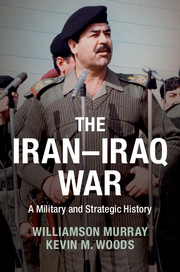Book contents
- Frontmatter
- Dedication
- Contents
- List of figures
- List of tables
- Preface
- Acknowledgments
- Note to reader
- 1 Introduction
- 2 A context of “bitterness and anger”1
- 3 The opponents
- 4 1980: The Iraqi invasion begins
- 5 1981–1982: Stalemate
- 6 Defeat and recovery
- 7 1983–1984: A war of attrition
- 8 1985–1986: Dog days of a long war
- 9 1987–1988: An end in sight?
- 10 Conclusion
- Appendix A Timeline
- Appendix B People
- Appendix C Place names
- Appendix D Order of battle
- Bibliography
- Index
- References
5 - 1981–1982: Stalemate
Published online by Cambridge University Press: 05 September 2014
- Frontmatter
- Dedication
- Contents
- List of figures
- List of tables
- Preface
- Acknowledgments
- Note to reader
- 1 Introduction
- 2 A context of “bitterness and anger”1
- 3 The opponents
- 4 1980: The Iraqi invasion begins
- 5 1981–1982: Stalemate
- 6 Defeat and recovery
- 7 1983–1984: A war of attrition
- 8 1985–1986: Dog days of a long war
- 9 1987–1988: An end in sight?
- 10 Conclusion
- Appendix A Timeline
- Appendix B People
- Appendix C Place names
- Appendix D Order of battle
- Bibliography
- Index
- References
Summary
If they had stood firm for just [a few] minutes, had they opened fire … and shot just one round off of each tank and then retreated, that would have been bad but they could have hit at least a percentage of the enemy forces coming [at] them. The force that stands firm does not give up losses; I wish to know the reason for this so I can punish them.
– Saddam HusseinIn his decision to invade Iran in September 1980, Saddam Hussein failed to understand his army’s limited capabilities and tried to do too many things at once. The Iraqis lost valuable time and surprise with the distractions of attacking Khorramshahr, Abadan, and Susangard. And if Saddam had intended to deprive Iran of Khuzestani oil to protect his gains, then the failure to capture Ahvaz, the crucial pipeline junction east of Dezful, and its associated road and rail infrastructure, all within reach, was a serious mistake. (For the extent of the southern, central, and northern battlefields in 1981 and 1982, see Figures 5.1, 5.2 and 5.3.)
Instead, the invading Iraqi forces focused on the port cities – where the majority of the Arabic-speaking population resided – largely because Saddam’s intelligence services had reported those Arabs would rally to the Iraqi cause. But that decision did not pan out when the locals were less than receptive to Saddam’s message. To make matters worse, a handful of atrocities by the Iraqis had turned otherwise neutral Arabs in the area into supporters of the regime in Tehran. In fact, the 9th Division commander, Major General Tala al-Duri, admired by Saddam and despised by fellow officers, had ordered the summary execution of locals suspected of supporting Iranians.
- Type
- Chapter
- Information
- The Iran–Iraq WarA Military and Strategic History, pp. 138 - 170Publisher: Cambridge University PressPrint publication year: 2014



